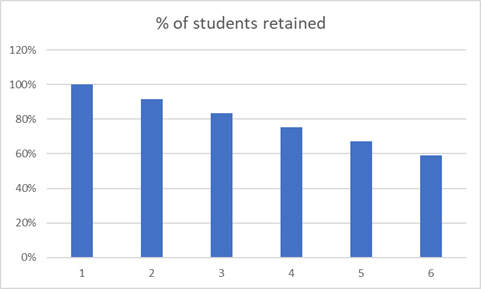"Now, don't take this the wrong way." We're sure that you've heard that expression before, often just before someone says something that is meant to come across as honest but could indirectly lead to hard feelings or rejection. The intent is good, but sometimes it's the tone in which the message is delivered that ultimately creates displeasure.
There are certain situations that in order to fix a problem, we must first agree there is a problem. While our intentions are indeed to retain students, and we try hard, there is a factor working fast against our best intentions.
That is the pressure being placed on Admissions offices today: to stabilize the financial state of the institution by perpetuating a model designed to fill seats left open by attrition. The worse the retention, the more Admissions will be under pressure to produce enough freshman to keep the doors open.
This is not just about completion rates; this also includes students that transfer, along with those that leave the institution for a myriad of other factors.
The U.S. national 6-year graduation rate is 59%*, which means that 41% of all students who started college in 2011 paid tuition, matriculated, but did not receive a degree.
The following graph is the standardized percentage of students succeeding for EVERY American institution of higher education (2011-2017).

Our tendency for this ugly picture is to state this is not a strategy, and that we fight against it every day by employing ever improving methods for education and retention. However, we've never once heard a college administrator advocate for a smaller admissions headcount to better focus on the students who will succeed. Such a suggestion is absent in meetings because any institution (with few exceptions) who unapologetically shrink the freshman class to include only those best fit to learn would soon shutter their doors, resulting in layoffs, sale of property and other assets, deep accumulation of debt, etc. under the weight of its business cost. The fact is, this is the cruel reality in Higher Ed, and it does not allow us to deny our existing strategy.
So what to do? We should be impetuous in creating strategies to retain as many students we can. That is the only way to redeem our basic need to fill seats. This means we should focus less on traditional conversations and act.
Here is an example:
Registration wait-lists will tell you exactly what courses students want that they don’t have access to take. As an institution, are you acting on that data? Is internal reluctance to react quickly to this information still an impediment? If so, one must remind everyone of the graph included above. If, in light of information about how badly we are failing, we are still unable to act, then we have to accept that our own comfort is built on the failure of 41% of the lives we touch.
Don't take this the wrong way, but will you chose to be impetuous?
* https://nces.ed.gov/fastfacts/display.asp?id=40
https://www.collegeraptor.com/find-colleges/articles/college-comparisons/2-key-statistics-for-comparing-colleges-graduation-rate-and-retention-rate-explained/




